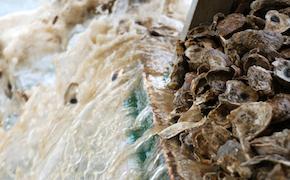A more acidic bay could make it more difficult for mollusks, such as oysters, to build their shells through a process called calcification. But it could help crustaceans, such as blue crabs, build their shells more quickly, said Justin Ries, a professor at the Marine Science Center at Northeastern University in Boston.
This could disrupt the evolutionary balance of the two, Ries said, because blue crabs prey on oysters.
Ries reached these conclusions after growing oysters and blue crabs under lab conditions of high carbon dioxide (higher than found in nature now). His research doesn’t mimic nature, Ries said, but it does provide clues to how increased acidification in the bay could affect the two organisms in the future.
Typically, about 30 percent of carbon dioxide in the atmosphere is absorbed into oceans, where it becomes carbonic acid and makes the water more acidic. As carbon dioxide becomes more prevalent in the atmosphere, more of it ends up in the ocean as well.
Atmospheric concentrations of carbon dioxide have increased by about 36 percent – from about 280 parts per million to 400 parts per million – in the past 200 years, said Whitman Miller, a research scientist with the Smithsonian Environmental Research Center.
The last time atmospheric carbon dioxide levels increased by 120 ppm was in the pliocene era – 2.6 to 5.3 million years ago – and that increase took 10,000 years, Miller said.
Since the Industrial Revolution, which began in about 1760, the ph level – the scale of how acidic water is – of the world’s oceans has decreased by 0.11, indicating a 28.8 percent increase in acidity, according to the National Oceanic and Atmospheric Administration’s Pacific Marine Environmental Laboratory. Further decreases in the ph level of 0.1 to 0.5 are expected during the next 100 years, according to a 2009 paper by Miller.
Ninety-seven percent of climate scientists agree that climate change trends over the past century are caused by human activities that are adding carbon dioxide to the atmosphere at historically high rates.
In the Pacific Northwest, oyster larvae have already been struggling to build their shells, according to the Ocean Conservancy, a nonprofit group advocating for healthy oceans.
Coral is also vulnerable to acidification; a 2009 Oceanography Society study found that an increase in ocean acidity will make it harder for coral to grow.
It’s more difficult to predict how acidification will affect the bay, Miller said. Things get more complicated when saltwater and freshwater meet in the bay, and there are other complicating factors, such as how deep the water is in different parts of the bay.
“The Chesapeake Bay is a really complicated system,” Miller said. “When we think of acidification, we’ve got to think about it differently than we do in the open ocean because the sort of absence of this really convenient equilibrium.”
State Delegate Eric Luedtke, D-Montgomery, is sponsoring a bill that would require the Maryland Department of the Environment to evaluate probable effects of acidification in the bay and other state waters and include recommendations about how to address the issue in a 2015 report.
Luedtke said acidification could “absolutely” hurt watermen who make their living from the oyster and crab industries in the bay.
“It creates a real change in ocean ecosystems for shellfish,” he said, “and Maryland being a state that is very oriented towards the water, I think it’s important that we sort of develop a strategy at the state government level to deal with the consequences of this.”
Little research on acidification in coastal systems has been done, and it’s badly needed, Miller said. In order for the Maryland Department of the Environment report to be successful, he said the report must be assembled by a wide range of people, including scientists, policymakers, watermen and people who manage natural resources.
Some watermen, however, are skeptical that the bill would help identify negative effects of acidification and ways to combat them.
Tim Devine, owner of Barren Island Oysters in Hoopers Island, said he hopes his oysters can be resilient against acidification because he feels helpless to do anything about it – even with Luedtke’s bill.
“There’s nothing a group of politicians comes up with that’s going to end up helping us out. That’s just the way it goes,” he said. “By the time it gets agreed upon, it doesn’t do anything.”
Steve Allen, of the Oyster Recovery Partnership, said Luedtke’s bill could help improve understanding of acidification in the bay.
“I think it’s more important to have correct science investigate potential issues that could arise from ocean acidification,” he said. “That way, we can be ready for it when and if it does occur.”
The “single best” way to combat acidification in the long term, Luedtke said, is to reduce greenhouse gas emissions. But, he added, there’s lag time associated with this; even if greenhouse gas levels were cut, it would take a long time for the effects it could have on acidification to be felt.
The effects that acidification could have on the bay and its inhabitants are unclear. But he believes that better understanding of the phenomenon – whether or not Luedtke’s bill facilitates this – is possible.
“Because of its complexity, it means it’s a headache to work in in some respects,” Miller said. “But if we can understand what’s happening in the Chesapeake Bay, we can understand what’s happening in almost any coastal system just by means of its complicated nature.”
Brian Compere, Capital News Service



Write a Letter to the Editor on this Article
We encourage readers to offer their point of view on this article by submitting the following form. Editing is sometimes necessary and is done at the discretion of the editorial staff.